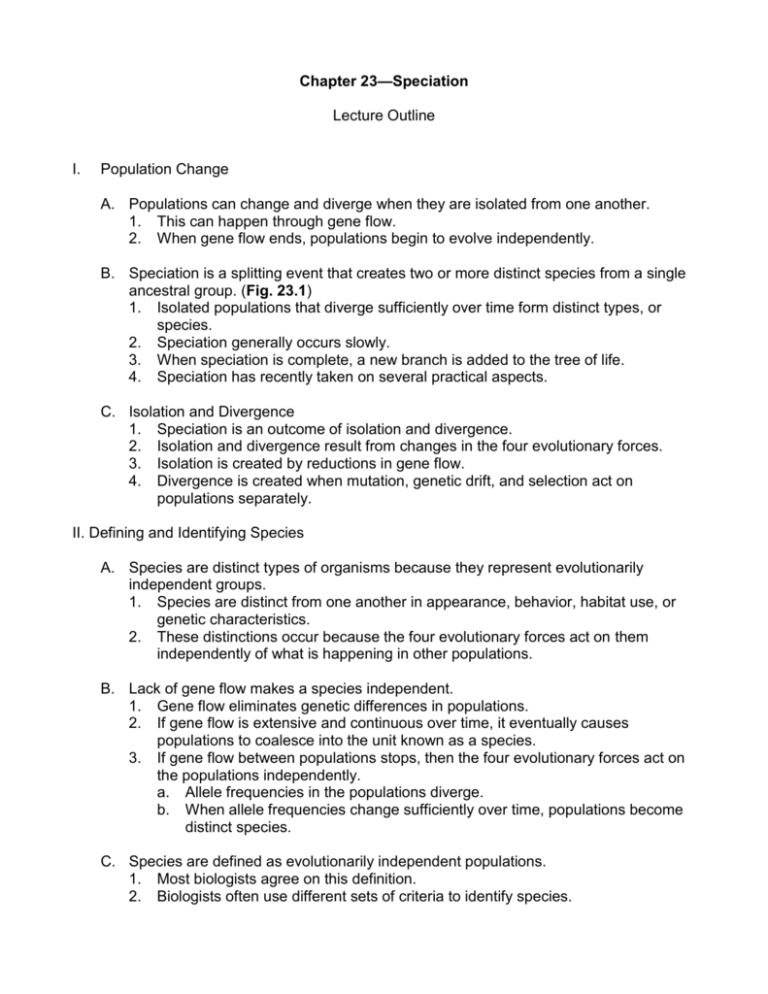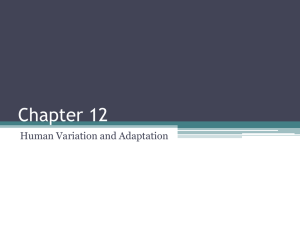Chapter 23: Speciation
advertisement

Chapter 23—Speciation Lecture Outline I. Population Change A. Populations can change and diverge when they are isolated from one another. 1. This can happen through gene flow. 2. When gene flow ends, populations begin to evolve independently. B. Speciation is a splitting event that creates two or more distinct species from a single ancestral group. (Fig. 23.1) 1. Isolated populations that diverge sufficiently over time form distinct types, or species. 2. Speciation generally occurs slowly. 3. When speciation is complete, a new branch is added to the tree of life. 4. Speciation has recently taken on several practical aspects. C. Isolation and Divergence 1. Speciation is an outcome of isolation and divergence. 2. Isolation and divergence result from changes in the four evolutionary forces. 3. Isolation is created by reductions in gene flow. 4. Divergence is created when mutation, genetic drift, and selection act on populations separately. II. Defining and Identifying Species A. Species are distinct types of organisms because they represent evolutionarily independent groups. 1. Species are distinct from one another in appearance, behavior, habitat use, or genetic characteristics. 2. These distinctions occur because the four evolutionary forces act on them independently of what is happening in other populations. B. Lack of gene flow makes a species independent. 1. Gene flow eliminates genetic differences in populations. 2. If gene flow is extensive and continuous over time, it eventually causes populations to coalesce into the unit known as a species. 3. If gene flow between populations stops, then the four evolutionary forces act on the populations independently. a. Allele frequencies in the populations diverge. b. When allele frequencies change sufficiently over time, populations become distinct species. C. Species are defined as evolutionarily independent populations. 1. Most biologists agree on this definition. 2. Biologists often use different sets of criteria to identify species. D. The Biological Species Concept 1. The critical criterion for identifying species is reproductive isolation. 2. No gene flow occurs between populations that are reproductively isolated from each other. 3. Populations are reproductively isolated if they fail to interbreed or to produce viable, fertile offspring. 4. Reproductive isolation cannot be evaluated in fossils or asexual species. E. The Morphospecies (form-species) Concept 1. Researchers identify evolutionarily independent lineages by differences in size, shape, or other morphological features. 2. Distinguishing features are most likely to arise if populations are independent and isolated from gene flow. 3. This is a very widely applicable concept. 4. It is useful when biologists have no data on the extent of gene flow. 5. It is equally applicable to sexual, asexual, or fossil species. 6. However, the features used to distinguish species are subjective and often involve disagreements. F. Phylogenetic Species 1. This is a recent addition to the tools available for identifying evolutionarily independent lineages. 2. The concept is based on reconstructing the evolutionary history of populations. 3. It is increasingly popular, widely applicable, and precise. 4. This concept is based on strong logic. (Fig. 23.2) a. All species are related by common ancestry. b. Phylogenies can be reconstructed to represent these relationships. (Box 23.1) c. A monophyletic group is an ancestral population, all of its descendants, and only all of its descendants. d. A species is defined as the smallest monophyletic group in a tree representing populations. 5. Advantages of the phylogenetic species concept: a. It can be applied to any populations. b. It is logical because populations are monophyletic only if they are independent of one another and isolated from gene flow. 6. However, carefully estimated phylogenies are available for only a tiny subset of populations. 7. This concept may also lead to the recognition of many more species than any other concept. G. In actual practice, researchers use all three species concepts. (Table 23.1) H. Species Definitions in Action 1. The dusky seaside sparrow is a good example of where species concepts come into play. (Fig 23.3a) a. Traditionally, researchers recognized several subspecies under the morphospecies concept. b. 2. 3. 4. 5. 6. Subspecies have distinguishing characteristics, but are not different enough to be full species. When one population became endangered, conservationists used the Endangered Species Act to help. a. The law uses the biological species concept to identify and rescue species from extinction. b. The sparrow became a priority because its populations were reproductively isolated. Hybrid offspring were created as breeding stock for a reintroduction program. The goal was to preserve as much genetic diversity as possible. The plan was thrown into turmoil when the phylogeny of this species was estimated. (Fig. 23.3b) a. Dusky seaside sparrows were found to be part of another monophyletic group. b. The population used for the hybrids was the other monophyletic group—the wrong one to use. The biological and morphospecies concepts had perhaps misled the conservation programs. III. Isolation and Divergence in Sympatry A. When populations or species live in the same geographic area, or at least close enough to make interbreeding possible, they are said to live in sympatry. B. Traditionally, it was thought that speciation could not occur among sympatric populations because gene flow was possible and could overwhelm any differences that might arise by drift or selection. 1. Example—Water snakes native to Lake Erie region. (Fig. 23.4) a. On islands, young unbanded snakes survive better than do young banded snakes. b. Gene flow has prevented natural selection from forming two separate species here. 2. Gene flow can prevent speciation because it overwhelms the diversifying force of natural selection. C. Natural selection can cause speciation even when gene flow is possible. 1. Several recent studies have shown that sympatric speciation is neither rare nor nonexistent. 2. Under certain circumstances, natural selection that causes populations to diverge can overcome gene flow and cause speciation. 3. Example—Scott Carroll researched speciation of soapberry bugs. (Fig. 23.5a) a. These bugs feed on plants in the family Sapindaceae. b. Horticulturists brought three new species of sapindaceous plants to North America from Asia in the mid-twentieth century. These are known as exotic, or nonnative, plants. c. Soapberry bugs began using these exotic plants as hosts soon after they were introduced. d. The fruits of the exotic plants are much different from the fruits of native plants. e. f. g. h. (1) In soapberry bug populations that feed on native plants, beak length corresponds to the size of the host fruit. (2) If beak lengths in populations using the new plants evolved to match the size of the new fruits, then natural selection was producing divergence in a sympatric population. Experimental data confirm that soapberry bug populations exploiting exotic species have indeed changed due to natural selection for efficient use of host fruits. Historical data also showed that average beak length in native populations has declined sharply. (Fig. 23.5b) Beak length has changed because some soapberry bug populations have switched to a new host. Only time will tell whether the populations that exploit native and exotic host plants will become separate species. D. Mutation also plays a role in speciation. 1. It is clear that gene flow and natural selection play key roles in speciation. 2. By itself, mutation is normally an insufficient mechanism for evolutionary change. 3. In plants, a mutation known as polyploidy reduces gene flow between normal and mutant plants. a. This is a condition of having more than two complete sets of chromosomes. b. Because it reduces gene flow, it can and does lead to speciation. (Fig. 23.6) 4. Mistakes in meiosis often cause polyploidy and subsequent speciation. (Fig. 23.7) 5. Speciation by polyploidy is common and occurs very quickly. IV. Isolation and Divergence in Allopatry A. Speciation begins when gene flow is reduced or eliminated. 1. This also happens when populations become physically separated from each other. 2. Physical isolation occurs in two ways: (Fig. 23.8) a. A population can colonize a new habitat. b. A new physical barrier can split a widespread population into two or more isolated groups. B. Speciation that begins with physical isolation is called allopatric speciation. C. Dispersal and Colonization Isolate Populations 1. Example—Colonization of new finch species on the Galápagos Islands. 2. Colonization events are likely to trigger speciation, for two reasons: a. The physical separation between populations reduces or eliminates gene flow. b. Genetic drift will cause the old and new populations to diverge rapidly because the number of individuals involved in colonization is usually small. 3. Colonization, followed by drift and selection, is thought to be responsible for the dramatic speciation of Galápagos finches and many other island groups. D. Vicariance Events Isolate Populations 1. 2. 3. 4. If a new physical barrier splits the geographic range of a species, then a vicariance event has occurred. a. Examples of physical barriers include mountain ranges or rivers. b. Vicariance events are a leading explanation for speciation in tropical rain forests. Haffer studied allopatric speciation in the Amazon basin. a. Many Amazonian birds have geographic distributions, or ranges, that overlap. (Fig. 23.9a) b. These overlapping ranges are the result of vicariance events that happened during the ice ages. (1) Tropical bird species once had large, continuous forest ranges. (2) As the global climate cooled, the forests shrank into small pockets, or refuges, that were surrounded by large, dry expanses of grasslands and savanna. c. Climate change split widespread populations into a series of subgroups that were isolated in habitat islands. d. These vicariance events triggered allopatric speciation. e. Overlapping ranges exist today because populations are gradually expanding their ranges out and away from the original refuges. f. This proposal is known as the Pleistocene refugium hypothesis. Haffer’s hypothesis was recently supported by work done on the distributions of flowering plants in the Amazon. (Fig. 23.9b) However, many or most tropical species are older than the hypothesis predicts. V. Secondary Contact A. What happens when populations that have been isolated come into contact again? 1. Prezygotic Isolation a. Divergence has affected when, where, and/or how individuals in the population mate. b. It will make it unlikely that interbreeding will take place. c. Many different mechanisms exist. (Table 23.2) 2. When prezygotic isolation occurs, intermating is rare, gene flow is minimal, and populations continue to diverge. B. Prezygotic isolation may not exist, and the populations may begin interbreeding again. 1. Gene flow may take over and erase any distinctions between the populations. 2. Other possibilities may occur: a. Reinforcement (1) Hybrid offspring may struggle to survive and reproduce. (2) They may die early in development or fail to produce fertile offspring. (3) Postzygotic isolation has occurred. (4) Selected traits reinforce differences that developed while the populations were isolated from one another. (5) Example—Data on closely related fruit flies in the genus Drosophila. b. Hybrid Zones (1) Hybrid offspring are not always dysfunctional. 3. 4. (2) They may have features that are intermediate between the two parental populations. (3) Hybrid zones are geographic areas where interbreeding occurs and hybrid offspring are common. (4) Depending on hybrid fitness and the extent of parental breeding, these zones can be narrow or wide, and long- or short-lived. (5) Example—Recent work using mitochondrial DNA (mtDNA) sequences of two species of warblers. (Figs. 23.10a and 23.10b) c. New Species through Hybridization (1) Hybridization may lead to extinction, but it doesn’t have to. (2) Two species are isolated and diverge as separate species. (3) When they come in contact again, they begin interbreeding. The result is a third, new species that has unique combinations of alleles from each parental species. It thus has different characteristics. Example—Experiments on the relationship between three species of sunflowers. (Fig. 23.11) a. The researchers used “backcrossing” techniques and RAPD markers. b. They succeeded in recreating a speciation event.









